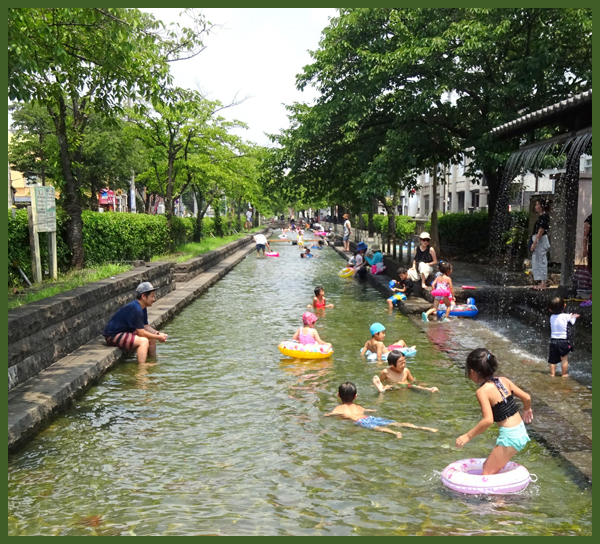. Famous Places and Power spots of Edo 江戸の名所 .
::::::::::::::::::::::::::::::::::::::::::::::::::::::::::::::::::::::::::::::::::::::::::::::::::::::::::::::::::::::::::::::::::::::::::::::::::::::::::::::::::::::::::::::::::::
Yotsugi 四つ木 Yotsugi district (Four Trees)
四つ木一丁目 - 四つ木五丁目 from First to Fifth district
- quote -
History of Yotsugi
The earliest mention of Yotsugi is an inscription on a statue of 聖徳太子 Shōtoku Taishi at 西光寺 Saikō-ji.
The statue has the presumably authentic date of 1341 written on it. This is roughly 140 years after Minamoto no Yoritomo’s death so let’s put some things into perspective, namely why is Yoritomo even relevant to the story? He may or may not be, but when he became the first shōgun of the 3 great shōgunates, his government put Kantō on the map – politically and economically speaking. Edo was just a fishing village at the time, but the proximity to the shōgunal capital of Kamakura was a massive boon to tiny villages in the area. By 1341, power had transferred back to Kyōto in western Japan with the establishment of the 室町幕府 Muromachi Bakufu Ashikaga Shōgunate. 140 years had passed and the prestige of Kantō was diminished.
The earliest surviving textual mention of Yotsugi comes to us from 1398 (Muromachi Period) in a document called 下総国葛西御厨注文 Shimōsa no Kuni Kasai Mikuri Chūmon Shimōsa Province’s Kasai Mikuri Annotation. It references a place called 四ツ木新田村 Yotsugi-Shinden Mura Yotsugi-Shinden Village.
In the Edo period, this area was primarily agricultural – fields and trees as far as the eye could see.
It fell under the administration of Edo Katsushika-gun 江戸葛飾郡 Katsushika District, Edo area. Yotsugi was technically under the direct control of the Tokugawa Shōgunate ...
It lay along the 本所上水 Honjo Jōsui Honjo Clean Water Aqueduct, which was later known as the 葛西用水 Kasai Yōsui Kasai Aqueduct or more popularly as the Hikifune-gawa 曳舟川 Hikifune River. The site where the Hikifune River and Ayase-gawa intersected offered a scenic riverside view that Edoites cherished. This spot was where the Hikifune Towpath began.
Because of its proximity to the shōgun’s capital and its scenic beauty, it was a popular destination for Edoites who wanted to get out of the city for a day or two. The most popular destinations were the religious institutions of 西光寺 Saikō-ji, 客人大権現 Maroudo Daigongen (modern 渋江白髭神社 Shibue Shirahige Jinja Shibue Shriahige Shrine), 木下川薬師 Kinoshita-gawa Yakushi (modern 浄光寺 Senkō-ji), and 柴又帝釈天 Shibamata Taishakuten. With the exception of Shibamata Taishakuten, these temples (and one shrine) are pretty minor, but in the Edo Period they were quite important.
During the Meiji Period, the area remained rural and agricultural – it was more or less unchanged from the Edo Period. However, in 1912 (Taishō 1), 四ツ木駅 Yotsugi Eki Yotsugi Station was built. This made the area accessible and factories that wanted to take advantage of the space, cheap land, and access to rivers for distribution and “waste disposal” were set up in the area. It’s around this time that the area became famous for the production of celluloid.
In 1922, a wooden bridge called Yotsugibashi 四ツ木橋 Yotsugi Bridge was built across the Arakawa River linking 墨田区 Sumida-ku Sumida Ward and 葛飾区 Katsushika-ku Katsushika Ward. In the chaos following the 1923 関東大震災 Kantō Daishinsai Great Kantō Earfquake, the 旧四ツ木橋 Kyū-Yotsugibashi Former Yotsugi Bridge – as it’s known today – was the site of wanton racist attacks against Chinese and Koreans living on the Sumida Ward side of the bridge. Apparently, some Tōkyōites blamed them for the earthquake or just took advantage of the chaos to indulge their own racism. At any rate, another wooden bridge was soon built and life went on as usual.
In the post-WWII years, the area rapidly urbanized. City historians cite the building of a new 四ツ木橋 Yotsugibashi Yotsugi Bridge in 1952 as making urbanization possible. Prior to the post-war era, cars were relatively rare in Tōkyō – trains and trolleys were the norm. The new bridge was a modern truss bridge made of steel that allowed automobile traffic to cross the Arakawa in this area. The area’s agricultural heritage began to fade quickly.
In 1964, the name was changed from 四ツ木 Yotsugi to 四つ木 Yotsugi
the only change was orthographic: katakana ツ tsu became hiragana つ tsu.
In 1989, during the Bubble Economy, the 曳舟川 Hikifune-gawa Hikifune River was filled in due to pollution and presumably to use it as a sewer. The remaining marshes that surrounded the river also became landfill. By 2000, the only left over bit of this once scenic Edo Period day trip spot was present-day Hikifune-gawa Shinsui Kōen 曳舟川親水公園 the Hikifune River Hydrophilic Park.
- source : Japanthis Marky Star ... -
. Hikifunegawa 曳舟川 Hikifune River .
Kasai Irrigation Water and the Kasai Yōsui 葛西用水 Kasai Waterway.
Hikifune Shinsui Koen 曳舟川親水公園 Hikifune Water Park
..............................................................................................................................................
- quote
Barges on the Yotsugi Dōri Canal 四ツ木通用水引ふね
A "hikifune (tugboat)"
is not propelled by a boatman using oars or a rod, but is moved by pulling a rope strung between the banks of the river, and usually carries passengers. What is pictured here is the Honjo irrigation canal, but since the river is narrow and the water is shallow, the only boat that could be used is the tugboat.
- source : Tokyo Metropolitan Library
..............................................................................................................................................
絵本江戸土産
- source :ameblo.jp/ame-ame511 yotsugi 四ツ木通用水引ふね -
- details : 絵本江戸土産を読む -
::::::::::::::::::::::::::::::::::::::::::::::::::::::::::::::::::::::::::::::::::::::::::::::::::::::::::::::::::::::::::::::::::::::::::::::::::::::::::::::::::::::::::::::::::::

- - - To join me on facebook, click the image !
:::::::::::::::::::::::::::::::::::::::::::::::::::::::::::::::::::::::::::::::::::::::::::::::::::::::::::::::::::::::::::::::::::::::::::::::::::::::::::::::::::::::::::::::::::::
. Katsushika ku 葛飾区 Katsushika ward .
. Kaido 街道 Highways - ABC Index .
. Famous Places and Powerspots of Edo 江戸の名所 .
. Edo bakufu 江戸幕府 The Edo Government .
. Japanese Architecture - The Japanese Home .
. Legends and Tales from Japan 伝説 - Introduction .
[ . BACK to DARUMA MUSEUM TOP . ]
[ . BACK to WORLDKIGO . TOP . ]
- - - - - #yotsugi #katsushika #hikifune #hikifunegawa - - - -
::::::::::::::::::::::::::::::::::::::::::::::::::::::::::::::::::::::::::::::::::::::::::::::::::::::::::::::::::::::::::::::::::::::::::::::::::::::::::::::::::::::::::::::::::::





No comments:
Post a Comment
Note: only a member of this blog may post a comment.